Native dominants or botanical ‘thugs’ in woodland.

Much has been written recent in recent years about the ‘dangers’ posed to our native flora & ecosystems by ‘alien’ invasive species. Introduced species such Himalayan Balsam (Impatiens glandulifera), Giant Hogweed (Heracleum mantegazzianum), and Rhododendron (Rhododendron ponticum) have been cited as ‘drivers’ of ecosystem change – alongside habitat loss, pollution and over-exploitation.
However, voices have been raised to express concern over certain native species that can grow rapidly producing large amount of biomass (or indeed necromass – think bracken dying down in late autumn) and how they may be impacting on our flora, particularly plants of the woodland herb or field layer.
Species that have fallen under suspicion are bracken (Pteridium aquilinum), bramble (Rubus fruticosus), ivy (Hedera helix), and nettle (Urtica dioica) – to which might be added dog’s mercury (Mercurialis perennis).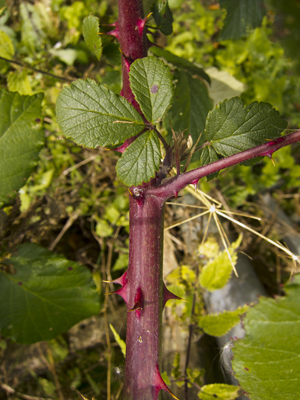 A recent paper (by Marrs, Kirby et al) in the New Journal of Botany† has examined the distribution of these plants in woodlands and other species associated with them in the field / herb layer.
A recent paper (by Marrs, Kirby et al) in the New Journal of Botany† has examined the distribution of these plants in woodlands and other species associated with them in the field / herb layer.
This was done through woodland surveys and analysis of the species found in the NVC woodland categories. Their initial work and inspection of existing literature indicates :
- That such species can achieve a high rate of cover as compared to other field layer species, leading to a suppression of slower growing species.
- Species such as Bracken, Ivy and Bramble are capable of dominating the local flora. They occur at a high frequency under the shade of the woodland canopy (and in glades or clear fell), where they can depress seedling growth and the field layer vegetation. The foliage of bracken and bramble can reach heights between 2 and 4 metres. However, bracken foliage does not fully develop until mid summer, so Spring-time (vernal) species such as bluebell can grow and flower.
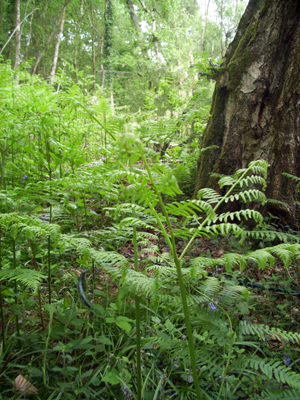 Bracken is known to release chemicals, which can inhibit the germination and growth of other species. For example, field experiments have demonstrated phytotoxic effects of bracken on Scots Pine (Dolling, 1996). However, it is not clear whether bracken’s phytotoxic effects are due to specific allopathic chemicals* or substances produced as a defence against herbivory.
Bracken is known to release chemicals, which can inhibit the germination and growth of other species. For example, field experiments have demonstrated phytotoxic effects of bracken on Scots Pine (Dolling, 1996). However, it is not clear whether bracken’s phytotoxic effects are due to specific allopathic chemicals* or substances produced as a defence against herbivory.
Phytotoxicity, plus bracken’s dense canopy and thick litter (in autumn / winter), all contribute to the failure of other plants to establish themselves. Bracken is often quick to regrow and dominate after fire. Bramble and Ivy can be held in check by the grazing of herbivores (deer). Another aspect (as yet un-determined?) is the possible effect of these native dominants on the recruitment of woodland tree species, and their germination / early growth.
However, before these plants are cast as the “villians of the piece” it is useful to remember that both provide cover and shelter for nesting birds, and a degree of protection for small mammals. The dead leaves of bracken can create a sheltered micro-climate for the winter months. 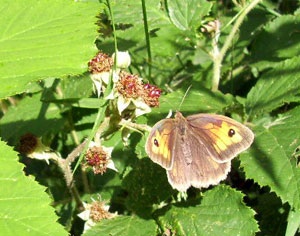 Brambles also offer food (berries) in late summer and autumn, and are important in supporting insect life – bramble nectar is important to butterflies, moths, bees, lacewings, hoverflies etc. Similarly, the flowers of ivy provide an autumnal source of nectar / pollen for many of these insects.
Brambles also offer food (berries) in late summer and autumn, and are important in supporting insect life – bramble nectar is important to butterflies, moths, bees, lacewings, hoverflies etc. Similarly, the flowers of ivy provide an autumnal source of nectar / pollen for many of these insects.
Nettles too have the potential to grow and expand in woodlands, perhaps aided and abetted by the increasing eutrophication (nitrate / phosphate enrichment) of habitats. Nettles are known to have a high phosphate requirement. (Nettles have had some interesting uses throughout history). Dog’s mercury can also have significant effects on the woodland field layer. Pigott (1977) originally showed that removal of dog’s mercury was followed by an increase in bluebells and primroses (Primula vulgaris).
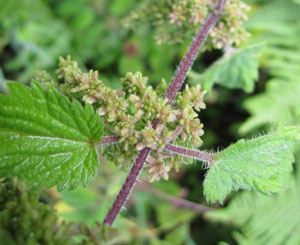 The further expansion of these native dominants may be influenced by changes in our climate. If certain projections of climate change are realized then brambles may be affected by a change in the climatic niche, as would dog’s mercury. However, Ivy and Bracken would probably be more tolerant, or unaffected by a change in the climate envelope of the UK. The reduced competitiveness of one or more these native dominants would not necessarily mean that there would be an increase in floral diversity - as another set of dominants might emerge.
The further expansion of these native dominants may be influenced by changes in our climate. If certain projections of climate change are realized then brambles may be affected by a change in the climatic niche, as would dog’s mercury. However, Ivy and Bracken would probably be more tolerant, or unaffected by a change in the climate envelope of the UK. The reduced competitiveness of one or more these native dominants would not necessarily mean that there would be an increase in floral diversity - as another set of dominants might emerge.
For those who might wish to bring bracken and bramble under control, then reference to “Managing your woodland for wildlife” by David Blakesley and Peter Buckley offers some useful advice.
* Allelopathy is also suspected with R. ponticum, and the unpalatable nature of its foliage is a defence against herbivores.
† Native dominants in British woodland - a potential cause of reduced species richness? - Marrs, Kirkby, Le Duc, McAllister, Smart, Oksanen, Bunce & Corney. New Journal of Botany, Volume 3, Number 3, 2013.
Comments are closed for this post.
Discussion
Invasive native species are a symptom of an ecosystem out of balance. The land manager has created the conditions whereby one of these magnificently adapted species is able to seize an opportunity and explode outwards, suppressing a more diverse ground flora. These population explosions do occur in nature, for example, rosebay willowherb after a forest fire in its native Canada (mimiced during the London blitz) but more often it is down to us. Bracken, bramble, nettle and dog’s mercury are all natural components of different NVC woodland types and in fact categorise some of them. Take away the tree cover, let in the light and whoooomf ! Or add more nitrogen and phosphate to the ground. Let’s just think more about the consequence of our actions.
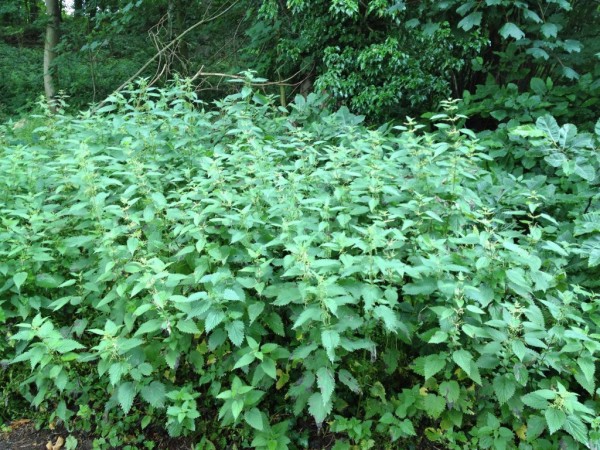

[…] This 'enrichment' of the environment with nitrogen (and phosphate) compounds encourages botanical thugs such as brambles and nettles – which can outcompete many plants of the herb layer [the diversity of […]
Woodlands and biodiversity | Woodlands.co.uk
31 March, 2018